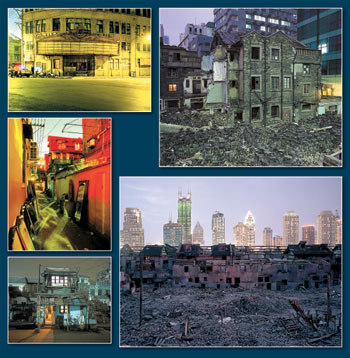| Tools: Save | Print | E-mail | Most Read |
| Shot in the Dark |
| Adjust font size: |
Girard comes across as a pensive, philosophical photographer with a rare talent for capturing beautifully haunting images of old Shanghai. Some have called his new pictures anthropological. In Girard's words, he was simply trying to "make a record". Girard's images of Shanghai show old buildings just before they were demolished. There are no people in these images, yet the pictures give the impression that life has been lived in these places. With a focus on atmosphere and colors, Girard shows what most people pay little attention to in the city: alleyways and staircases, as well as small homes in the midst of demolition, with glass skyscraper looming in the background and surrounding streets already swept away by change. The photos are, unusually, taken around dusk, when the falling light reveals the hidden shadows of an urban landscape illuminated by rubble and neon. The keyword is contrast. "When I first visited Shanghai back in 1983 I was struck by how the city looked as if there had been no urban development, at least not for profit, since 1949," Girard told China Daily. "It was as if Shanghai had fallen off the map." Since then, Shanghai has become the focus of worldwide attention. A lot has happened to the city's appearance, especially since the late 1990s. Girard's project began to take in 2001, three years after he moved to Shanghai. "I wanted to see and capture this very specific, unique moment in Shanghai's history, which is not going to last forever. It is the moment when an old city and a modern city are occupying the same space. In my pictures, you can still see both at the same time. "There is a sense that Shanghai has been unnaturally preserved almost by neglect or a lack of intervention. It seems simply an accident, because no one intended to save the old parts of the city. At the same time, the new unprecedented pace of urban development appears equally accidental." The title Phantom Shanghai refers to the ghostly way in which something is made to disappear, according to Girard. "When something dies, something lingers. There is some sense of it still being there, even when it is vanished," said Girard, comparing the experience with that of losing a limb. After an accident, according to many reports, most amputees still feel a twitch in their lost limb. To the question of whether Phantom Shanghai was a nostalgic project, Girard insisted that nostalgia held no interest for him. When asked if the project should be perceived as political, Girard commented: "Like everything in China, it does have a political side to it. But personally, I find it more to be of a historical nature. The pictures give a sense of what I would call layers of history or the heart-flow of time through the city." Girard suggested that it may well take an outsider to remind others of the beauty in the flaws, and to notice the fascinating phenomenon caught in what he calls "images of the threshold". In 1999, Girard published the Hong Kong photo book, City of Darkness: Life in Kowloon Walled City, in cooperation with Ian Lambot and Axel Menges. According to Girard, the two cities that he has documented in pictures, Hong Kong and Shanghai, do not compare. He explained that Hong Kong became what it is today because it picked up where Shanghai left off around 1949. "Shanghai's irrelevance became Hong Kong's relevance back then. But it is definitely a Shanghai moment right now," said Girard. During his endless hours of location hunting, Girard was confronted with different local attitudes towards the ongoing changes. Some said they felt "the old stuff" was holding them back. Other insisted that there was "no need to destroy the past". Around Huaihai Park, by the newly renovated Xintiandi district, some of the people whose lives have been directly affected by the changes go daily to socialize in the shade. One of them is an elderly man surnamed Xiong, who will soon have to leave the area. Surrounded by elders playing mahjong and taking care of grandchildren, Xiong gave his take on the battle for Shanghai's soul. "I still live on Shunchang Lu just by the park, but my apartment will be demolished and I will need to move far away to the Minhang District. I really can't do anything about the situation, but it is for the good of Shanghai's development. Sometimes it is needed for people to sacrifice themselves in order to develop the city," he said. A 48-year old male storekeeper by a nearby small restaurant at Xingan Lu pointed out that the residents of Shanghai are in the process of getting rid of the old in order to make way for the new. "There is nothing to be done about it," he said as he let out a weary sigh, "but at least the living standards are much better in the new places." The Phantom Shanghai exhibition is at Studio Rouge in Shanghai and at 798 Art District in Beijing.
(China Daily July 4, 2007)
|
| Tools: Save | Print | E-mail | Most Read |
 |
| Related Stories |

